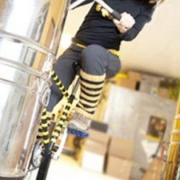How A 6-Pack Of Beer Inspired This Beekeeper’s Sweet Invention
Kristy Allen of The Beez Kneez on her Honey Cycle.The Beez Kneez
Kristy Allen, a beekeeper in Minneapolis, has built a thriving business doing what she loves best: Caring for bees.
She maintains hives, sells honey and teaches intensive beekeeping classes, all while maintaining environmentally sustainable practices. Her business, The Beez Kneez, pulls in some $200,000 a year in annual revenue. “When I started in 2010, we just didn’t anticipate that kind of growth, and it’s not waning,” Allen told The Story Exchange recently in this 18-minute podcast, Let’s Hear It For Honeybees.
But what Allen is most proud of is a device she has invented: the Beez Kneez Honey Cycle. Many beekeepers use a hand crank to extract honey from the comb. It looks “kind of like a butter churner that sits on the side of the machine,” Allen says. “It’s really awkward to use.”
A few years ago, Allen thought there must be a better way. An avid biker, she had initially started The Beez Kneez as a pedal-powered honey-delivery service. She had dressed like a bee — the costume included antennas and striped socks — and biked around Minneapolis, dropping off honey deliveries to restaurants, food co-ops and other clients.
So she went to her bike mechanic — a friend who has a “brilliant engineering mind” — and told him about the challenge of extracting honey by hand. “I said, ‘Help me make this pedal powered,’” she says. “And so I literally gave him a six-pack of beer, a


